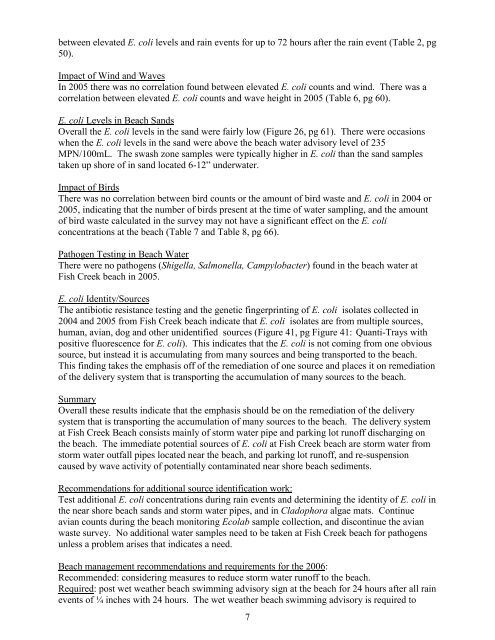2005 - Door County Web Map
2005 - Door County Web Map
2005 - Door County Web Map
Create successful ePaper yourself
Turn your PDF publications into a flip-book with our unique Google optimized e-Paper software.
etween elevated E. coli levels and rain events for up to 72 hours after the rain event (Table 2, pg<br />
50).<br />
Impact of Wind and Waves<br />
In <strong>2005</strong> there was no correlation found between elevated E. coli counts and wind. There was a<br />
correlation between elevated E. coli counts and wave height in <strong>2005</strong> (Table 6, pg 60).<br />
E. coli Levels in Beach Sands<br />
Overall the E. coli levels in the sand were fairly low (Figure 26, pg 61). There were occasions<br />
when the E. coli levels in the sand were above the beach water advisory level of 235<br />
MPN/100mL. The swash zone samples were typically higher in E. coli than the sand samples<br />
taken up shore of in sand located 6-12” underwater.<br />
Impact of Birds<br />
There was no correlation between bird counts or the amount of bird waste and E. coli in 2004 or<br />
<strong>2005</strong>, indicating that the number of birds present at the time of water sampling, and the amount<br />
of bird waste calculated in the survey may not have a significant effect on the E. coli<br />
concentrations at the beach (Table 7 and Table 8, pg 66).<br />
Pathogen Testing in Beach Water<br />
There were no pathogens (Shigella, Salmonella, Campylobacter) found in the beach water at<br />
Fish Creek beach in <strong>2005</strong>.<br />
E. coli Identity/Sources<br />
The antibiotic resistance testing and the genetic fingerprinting of E. coli isolates collected in<br />
2004 and <strong>2005</strong> from Fish Creek beach indicate that E. coli isolates are from multiple sources,<br />
human, avian, dog and other unidentified sources (Figure 41, pg Figure 41: Quanti-Trays with<br />
positive fluorescence for E. coli). This indicates that the E. coli is not coming from one obvious<br />
source, but instead it is accumulating from many sources and being transported to the beach.<br />
This finding takes the emphasis off of the remediation of one source and places it on remediation<br />
of the delivery system that is transporting the accumulation of many sources to the beach.<br />
Summary<br />
Overall these results indicate that the emphasis should be on the remediation of the delivery<br />
system that is transporting the accumulation of many sources to the beach. The delivery system<br />
at Fish Creek Beach consists mainly of storm water pipe and parking lot runoff discharging on<br />
the beach. The immediate potential sources of E. coli at Fish Creek beach are storm water from<br />
storm water outfall pipes located near the beach, and parking lot runoff, and re-suspension<br />
caused by wave activity of potentially contaminated near shore beach sediments.<br />
Recommendations for additional source identification work:<br />
Test additional E. coli concentrations during rain events and determining the identity of E. coli in<br />
the near shore beach sands and storm water pipes, and in Cladophora algae mats. Continue<br />
avian counts during the beach monitoring Ecolab sample collection, and discontinue the avian<br />
waste survey. No additional water samples need to be taken at Fish Creek beach for pathogens<br />
unless a problem arises that indicates a need.<br />
Beach management recommendations and requirements for the 2006:<br />
Recommended: considering measures to reduce storm water runoff to the beach.<br />
Required: post wet weather beach swimming advisory sign at the beach for 24 hours after all rain<br />
events of ¼ inches with 24 hours. The wet weather beach swimming advisory is required to<br />
7





![A Guide to the Control and Management of Invasive Phragmites [PDF]](https://img.yumpu.com/19126786/1/190x190/a-guide-to-the-control-and-management-of-invasive-phragmites-pdf.jpg?quality=85)






![Homeowner's Guide to Japanese Knotweed Control [PDF]](https://img.yumpu.com/19126766/1/190x245/homeowners-guide-to-japanese-knotweed-control-pdf.jpg?quality=85)



